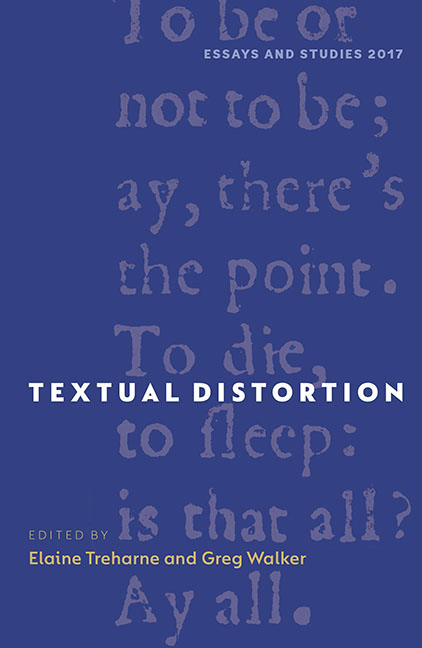Book contents
- Frontmatter
- Dedication
- Contents
- List of Illustrations
- Preface and Acknowledgements
- Notes on Contributors
- Introduction
- The Curious Production and Reconstruction of Oxford, Bodleian Library, Junius 85 and 86
- ‘Through a glass darkly’, or, Rethinking Medieval Materiality: A Tale of Carpets, Screens and Parchment
- Distortion, Ideology, Time: Proletarian Aesthetics in the Work of Lionel Britton
- Shakespeare and Korea: Mutual Remappings
- Dictionary Distortions
- Where Do Indigenous Origin Stories and Empowered Objects Fit into a Literary History of the American Continent?
- Distortion in Textual Object Facsimile Production: A Liability or an Asset?
- The Uncanny Reformation: Revenant Texts and Distorted Time in Henrician England
- The Presence of the Book
- Index
Distortion in Textual Object Facsimile Production: A Liability or an Asset?
Published online by Cambridge University Press: 24 August 2019
- Frontmatter
- Dedication
- Contents
- List of Illustrations
- Preface and Acknowledgements
- Notes on Contributors
- Introduction
- The Curious Production and Reconstruction of Oxford, Bodleian Library, Junius 85 and 86
- ‘Through a glass darkly’, or, Rethinking Medieval Materiality: A Tale of Carpets, Screens and Parchment
- Distortion, Ideology, Time: Proletarian Aesthetics in the Work of Lionel Britton
- Shakespeare and Korea: Mutual Remappings
- Dictionary Distortions
- Where Do Indigenous Origin Stories and Empowered Objects Fit into a Literary History of the American Continent?
- Distortion in Textual Object Facsimile Production: A Liability or an Asset?
- The Uncanny Reformation: Revenant Texts and Distorted Time in Henrician England
- The Presence of the Book
- Index
Summary
The aim of this essay is to analyse the concept of distortion in relation to the transmission of textual objects through the creation of facsimiles. The general claim of the essay is that, paradoxically, the process of distortion is itself an essential means to get rid of distortion; this concept will become clearer as we explain the different kinds of distortion that we encounter in the process of producing a facsimile edition of a medieval manuscript. Each type of distortion comes from a specific stage of the facsimile-making process.
As we retrace the process from start to finish, the four main stages of production will be described; namely, the photo-setting, pre-press, printing and binding stages. Each stage will be discussed in relation to the type of alteration it deals with or causes. With reference to practical examples, it will be argued that distortion can be either positive or negative depending on context, use and aim. A sequence of manuscripts will be taken into consideration to further demonstrate how distortion plays a main role in the art of facsimile making.
Starting from the definition of perception as the means by which we determine alteration, there will be a discussion of how the use of different colour systems can lead to different outcomes, in terms of perception and distortion. This discussion will take place in the context of the pre-press and printing stages. The latter will allow us to talk about how perception is fundamental in the creation of a facsimile; although based on science and technology, it can be safely stated that the process of facsimile making is far from being an exact science and it involves technical skills, art and craftsmanship in almost equal measure. For example, the process of colour proofing is a testament to such abilities and it relates to the concept of distortion, for its purpose lies in limiting distortion to create a printed facsimile as close as possible to the original document.
One last aspect of distortion – the ‘commercial’ or exogenous – will also be evaluated. With this terminology we are indicating nothing less than the alteration of facsimiles to the point where they can no longer be considered as such.
- Type
- Chapter
- Information
- Textual Distortion , pp. 117 - 129Publisher: Boydell & BrewerPrint publication year: 2017

